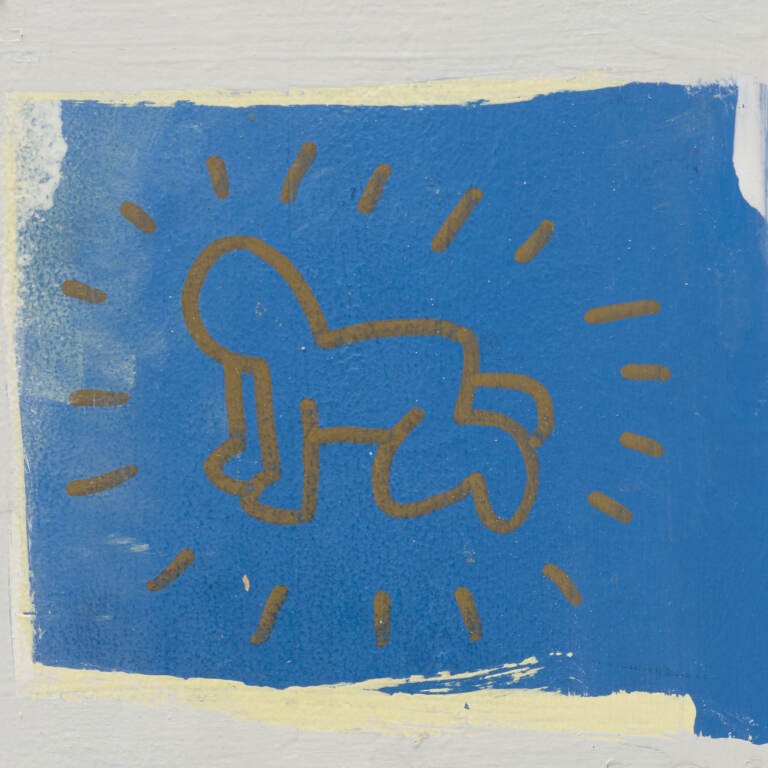“Radiant Baby” by Keith Haring. It’s may look like a doodle, but this is the progenitor doodle that launched countless murals, paintings, posters, and more.
Graffiti art isn’t typically my thing. I tend to gravitate towards more structured forms of expression, although I also privately speculate that’s because I simply may not be cool enough to grok the vibe. But like every creative genre and style, there are outlier exceptions that defy day-to-day expectations.
The energetic, whimsical line drawings of Keith Haring (1958-1990) fit that bill. A visual artist of singular vision, Haring left an indelible iconography that’s managed to endure beyond his tragically short lifespan. His signature style consists of blocky, abstract stick figures captured in action poses as if snapped by a camera and strobe.
In some ways, Haring’s graphics anticipate the wired world. He died just before the World Wide Web emerged, but even so, his unique images appeared far and wide in popular publications, murals, t-shirts, political posters, and more. They entered the global visual lexicon as if they had always existed, as if they were pop culture inevitabilities. The quirky, often clever drawings he scrawled over surfaces of all kinds had—and continue to have— the ability to be easily reproduced. To this day it’s easy to find gifs, doodles, online memes, and other graphical references that instantly recall Haring’s jam. Perhaps more important, the substance of his oeuvre brought light, energy, and vital attention to the emerging crisis of the late 20th century AIDS crisis, and gave critical voice and identity to the gay community in ways that were not only daring and transformative for their time, but continue to remain vibrant and essential today. That Haring’s work invited everyone to enjoy regardless of orientation or political affiliation, however, speaks to his universal appeal.
Like all creative people, famous and anonymous, Haring had to grow up somewhere. He started in inauspicious circumstances, in a home, in an ordinary town, figuring out how to find his way through the world like the rest of us. His particular origin largely began in Kutztown, Pennsylvania where he lived in a charming old brick house on Whiteoak Street with his parents and three sisters. In his bedroom at the back of the house, he marked the eastern wall with what would become his signature image, his so-called “Radiant Baby”. Over the years that trippy little glyph would appear countless times in endless works, and it largely defined the overall spirit of Haring’s sensibilities, specifically movement, playfulness, surprise, and implications of transformation to come.
Years after the Harings moved out of that house, a young couple purchased the place with the goal of fixing it up. They had a family and set about living their lives and making a home. They knew there was a curious image on the wall in the back bedroom attributed to the late artist, but it would take some sleuthing to realize its deeper legacy. After twists, turns, and ultimately a certified letter of authenticity from Keith Haring’s elderly father who now lives a few miles away, they realized they were stewards of a piece of cultural history. Radiant Baby still shines in reproductions around the world, but it began inauspiciously, a gold outline on a blue background, painted adjacent to a light switch in a teenage bedroom. In a couple of weeks, it goes to auction. The painting has been surgically cut from the house, including the light switch.
The current owners of the former Haring homestead—Scott, Angie, and their high school senior son Reed—talk about the sale with mixed emotions. (I’ve withheld their last name to give them a thin screen of privacy.) They certainly know there’s real value in the painting. It is, after all, the genesis moment for one of pop art’s most famous icons, and bidders from around the world are expected to offer serious sums for the work mounted on an actual a piece of Haring’s childhood home. But this isn’t all about capital returns. They’ve lived with Radiant Baby in the back room for almost twenty years. Angie summed it up nicely: “Others in the world should see this besides just us.”
That’s the thing about creative work. When creative expressions are shrouded in obscurity culture cannot grow. When creative work gets released from its moorings, we are all set free to encounter new ideas, to meet new worlds, to think new thoughts. It’s not that Keith Haring defines the zenith of American art. It’s not that this sale will change how wide portions of the cultural firmament interact with unexpected voices. What matters here is that in a time when we are all being overwhelmed by media synthesized either from carefully managed corporate committees, or ceaseless chatter from social media, a small painting on a piece of a former teenager’s bedroom wall is enough to make us stop and smile and notice how it, too, has influence—perhaps even more lasting influence than any disposable electronic signal that may tempt us for ten irrelevant seconds.
As far as I’m concerned, that’s a radiant thought if ever there was one.

